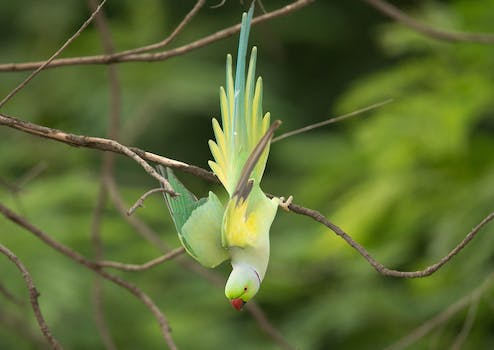

-
Table of Contents
"Unlock the secrets to a harmonious bond with our 10 Tips and Tricks for Taming Lovebirds."
Introduction
Lovebirds are beautiful and social birds that make wonderful pets. However, they can also be quite challenging to tame and train. If you're a lovebird owner looking to establish a strong bond with your feathered friend, here are 10 tips and tricks to help you in taming lovebirds effectively.
Understanding Lovebird Behavior: 10 Tips and Tricks for a Happier Pet
Lovebirds are beautiful and intelligent birds that make wonderful pets. However, understanding their behavior can sometimes be a challenge. In this article, we will explore ten tips and tricks for taming lovebirds and creating a happier pet.
1. Patience is key when it comes to taming lovebirds. These birds are naturally cautious and may take some time to warm up to you. It's important to give them space and allow them to approach you at their own pace.
2. Building trust is crucial in taming lovebirds. Spend time near their cage, talking softly and offering treats. This will help them associate your presence with positive experiences.
3. Socialization is essential for lovebirds. Introduce them to different people and environments to help them become comfortable with new experiences. This will make them more confident and less fearful.
4. Lovebirds are highly intelligent creatures, so mental stimulation is important. Provide them with toys and puzzles that challenge their problem-solving skills. This will keep them entertained and prevent boredom.
5. Lovebirds are social animals and thrive on companionship. If you have only one lovebird, consider getting another one as a companion. This will prevent loneliness and provide them with a sense of security.
6. Training lovebirds can be a rewarding experience. Start with simple commands like "step up" and reward them with treats when they comply. This will help establish a bond and make them more responsive to your commands.
7. Lovebirds are known for their vocalizations, which can sometimes be loud. To prevent excessive noise, provide them with plenty of toys and activities to keep them occupied. This will redirect their energy and reduce the need for constant vocalization.
8. Lovebirds are naturally curious and love exploring their surroundings. Create a safe environment for them to fly and play outside their cage. This will give them the opportunity to exercise and satisfy their natural instincts.
9. Lovebirds have a strong bond with their owners and enjoy physical contact. Gently stroke their feathers and offer them head scratches to build a deeper connection. This will make them feel loved and secure in your presence.
10. Lastly, lovebirds require a balanced diet to stay healthy and happy. Provide them with a variety of fresh fruits, vegetables, seeds, and pellets. Avoid feeding them foods that are toxic to birds, such as chocolate or avocado.
In conclusion, taming lovebirds requires patience, trust-building, and socialization. By following these ten tips and tricks, you can create a happier and more well-adjusted pet. Remember to provide mental stimulation, companionship, and a safe environment for them to thrive. With time and effort, your lovebird will become a loving and affectionate companion.
Creating the Perfect Environment for Lovebirds: 10 Tips and Tricks for a Healthy Habitat

Lovebirds are beautiful and intelligent birds that make wonderful pets. However, they can also be quite demanding and require a specific environment to thrive. Creating the perfect habitat for your lovebirds is essential for their health and happiness. In this article, we will provide you with 10 tips and tricks to help you create a healthy habitat for your lovebirds.
1. Cage size matters: Lovebirds are active birds that need plenty of space to move around. A cage that is too small can lead to stress and behavioral problems. Aim for a cage that is at least 24 inches wide, 18 inches deep, and 24 inches tall.
2. Choose the right location: Place the cage in a quiet area of your home, away from drafts and direct sunlight. Lovebirds are sensitive to temperature changes, so it's important to keep them in a stable environment.
3. Provide perches and toys: Lovebirds love to climb and explore. Offer a variety of perches at different heights and textures to keep them entertained. Toys such as swings, bells, and puzzles will also help stimulate their minds.
4. Offer a balanced diet: Lovebirds need a diet that consists of high-quality pellets, fresh fruits, vegetables, and seeds. Avoid feeding them avocado, chocolate, caffeine, and alcohol, as these can be toxic to birds.
5. Fresh water is a must: Make sure your lovebirds always have access to fresh, clean water. Change the water daily and clean the water dish regularly to prevent the growth of bacteria.
6. Maintain proper hygiene: Lovebirds are prone to feather dust, which can cause respiratory problems. Regularly clean their cage, perches, and toys to minimize dust accumulation. Additionally, provide them with a shallow dish of water for bathing.
7. Keep the environment stimulating: Lovebirds are intelligent birds that need mental stimulation. Rotate their toys regularly to keep them engaged and provide them with opportunities for foraging and problem-solving.
8. Monitor the temperature and humidity: Lovebirds are sensitive to extreme temperatures and humidity levels. Keep the temperature between 65-80°F (18-27°C) and the humidity between 40-60%. Use a thermometer and hygrometer to monitor these levels.
9. Provide a safe environment: Lovebirds are curious creatures and can get themselves into trouble. Remove any toxic plants, chemicals, or small objects that they could swallow. Also, be cautious of open windows and doors to prevent accidental escapes.
10. Spend quality time with your lovebirds: Lovebirds are social birds that thrive on companionship. Interact with them daily, talk to them, and offer them treats. They will appreciate the attention and bond with you more strongly.
In conclusion, creating the perfect environment for your lovebirds is crucial for their well-being. By following these 10 tips and tricks, you can ensure that your lovebirds have a healthy habitat that meets their physical and mental needs. Remember, a happy lovebird is a healthy lovebird!
Bonding with Your Lovebird: 10 Tips and Tricks for Strengthening the Relationship
Lovebirds are known for their affectionate nature and strong bond with their owners. However, building a strong relationship with these beautiful birds requires time, patience, and understanding. In this article, we will explore ten tips and tricks for taming lovebirds and strengthening the bond between you and your feathered friend.
1. Start with a calm and quiet environment: Lovebirds are sensitive creatures, and a calm and quiet environment is essential for them to feel safe and secure. Find a peaceful spot in your home where you can interact with your lovebird without distractions or loud noises.
2. Respect their personal space: Just like humans, lovebirds need their personal space. Respect their boundaries and avoid forcing them into interactions. Allow them to approach you at their own pace, and gradually build trust and familiarity.
3. Offer treats as positive reinforcement: Lovebirds are highly motivated by food, so offering treats can be an effective way to encourage positive behavior. Use small, healthy treats like millet sprays or fresh fruits as rewards for good behavior, such as stepping onto your hand or coming when called.
4. Use gentle and consistent handling: When handling your lovebird, always be gentle and avoid sudden movements. Start by placing your hand near their cage and allow them to get used to your presence. Slowly progress to offering your hand for them to step onto, rewarding them with treats when they do so.
5. Spend quality time together: Lovebirds thrive on social interaction, so it's important to spend quality time with them every day. Set aside dedicated time for bonding activities, such as talking to them, offering head scratches, or playing with their favorite toys. This regular interaction will help strengthen your bond.
6. Provide mental stimulation: Lovebirds are intelligent birds and need mental stimulation to stay happy and engaged. Offer a variety of toys, puzzles, and foraging opportunities to keep their minds active. Rotate their toys regularly to prevent boredom and provide new challenges.
7. Communicate through body language: Lovebirds are highly observant and can pick up on your body language. Use gentle movements and a calm demeanor to communicate with them. Avoid sudden gestures or loud noises that may startle or frighten them.
8. Introduce them to new experiences gradually: Lovebirds can be wary of new experiences, so introduce them gradually to new environments, people, or objects. Allow them to explore at their own pace, providing reassurance and rewards for their bravery.
9. Incorporate positive reinforcement training: Lovebirds can be trained to perform simple tricks or behaviors using positive reinforcement techniques. Use clicker training or verbal cues paired with treats to teach them commands like "step up" or "wave." This training not only strengthens your bond but also provides mental stimulation for your lovebird.
10. Be patient and consistent: Building a strong bond with your lovebird takes time and patience. Each bird is unique, and some may take longer to trust and bond with their owners. Be consistent in your interactions, and don't get discouraged if progress seems slow. With time and dedication, your lovebird will become a cherished companion.
In conclusion, taming lovebirds and strengthening the bond with these delightful birds requires a calm environment, respect for their personal space, positive reinforcement, and consistent handling. Spending quality time together, providing mental stimulation, and introducing new experiences gradually are also crucial. Communicating through body language, incorporating positive reinforcement training, and being patient and consistent will help you build a strong and loving relationship with your lovebird.
Q&A
1. What are some tips for taming lovebirds?
- Spend time near their cage to get them used to your presence.
- Offer treats and rewards to create positive associations.
- Speak softly and avoid sudden movements to avoid scaring them.
- Gradually introduce your hand into their cage, allowing them to get comfortable with it.
- Use a perch or stick to encourage them to step onto your hand.
- Be patient and consistent in your interactions with them.
- Avoid forcing them to do anything they are uncomfortable with.
- Provide a safe and comfortable environment for them to feel secure.
- Socialize them with other people and birds to help them become more comfortable.
- Seek advice from experienced bird owners or avian veterinarians if needed.
2. How can I gain the trust of my lovebirds?
- Spend time near their cage, talking to them and offering treats.
- Move slowly and avoid sudden movements that may startle them.
- Offer treats from your hand, allowing them to approach and take it at their own pace.
- Use positive reinforcement, such as praise and rewards, to create positive associations.
- Be patient and consistent in your interactions, allowing them to gradually become more comfortable with you.
- Avoid forcing them to do anything they are uncomfortable with.
- Respect their boundaries and give them space when needed.
- Provide a safe and secure environment for them to feel at ease.
- Avoid loud noises or sudden changes in their surroundings that may cause stress.
- Spend quality time with them daily, engaging in activities they enjoy.
3. How can I socialize my lovebirds with other birds?
- Introduce them to other birds gradually, starting with short supervised interactions.
- Use a neutral space for the initial meetings, away from their cages.
- Observe their body language and behavior to ensure they are comfortable.
- Provide plenty of perches and toys to keep them occupied during socialization.
- Offer treats and rewards to create positive associations with the presence of other birds.
- Monitor their interactions closely to prevent any aggressive behavior.
- If any signs of aggression occur, separate the birds and try again later.
- Gradually increase the duration and frequency of their interactions over time.
- Seek advice from experienced bird owners or avian veterinarians for guidance on socializing lovebirds.
- Remember that not all lovebirds may enjoy or be compatible with socializing, so respect their individual preferences.
Conclusion
In conclusion, implementing these 10 tips and tricks for taming lovebirds can greatly improve the bond between owners and their feathered companions. By providing a calm and comfortable environment, offering regular socialization and training sessions, and being patient and consistent in their approach, owners can successfully tame their lovebirds and enjoy a loving and interactive relationship with them.












